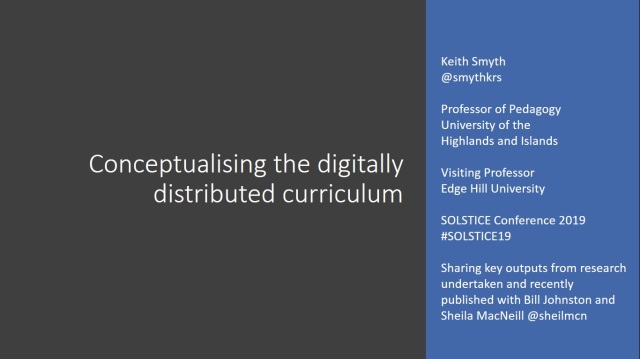On Wednesday 5th June this week I’m presenting at the annual SOLSTICE 2019 e-learning conference at Edge Hill University, which is organised and run as a joint conference by Edge Hill’s SOLSTICE Centre for Excellence in Teaching and Learning (@SolsticeCETL) and the Centre for Learning and Teaching at EDU (@CLTatEHU).
The joint SOLSTICE and CLT conference at Edge Hill is long since a well established event, running early each June and featuring a range of internal and external speakers. External speakers include a number of Visiting Fellows and Visiting Professors attached to the Centre for Learning and Teaching, not least Professors Sally Brown and Phil Race, Professor Peter Hartley, Simon Thomson and Sue Beckingham, amongst other experienced colleagues in the fields of learning and teaching, academic development and digital education practice. I count myself fortunate to also be in a Visiting Professor role at Edge Hill University, as I have benefited in various ways through learning from the work of the aforementioned folks and, in some instances, collaborating with them.
I have also been fortunate to know and learn from Professor Mark Schofield, Dean of Learning and Teaching and Director of the Centre for Learning and Teaching at EDU, in a range of ways over the years. This includes Mark’s time as External Examiner for a Masters programme in blended and online education I used to run, many years ago now and while still definitely very wet behind the ears. As they are want to say around Merseyside way, and as Mark has said a few times, ‘I knew him as a lad, you know’.
As with the previous occasions I’ve been lucky enough to attend since the early 2000’s, the SOLSTICE and CLT 2019 Conference Programme looks excellent. I’m particularly looking forward to a number of sessions that between them are exploring key concepts, ideas and approaches relating to creativity, inclusion and resilience in relation to learning and teaching and digital education practice.
My own session for the conference this week is on the topic of ‘Conceptualising the digitally distributed curriculum’.

There is something of a continuity here too, as the session is partially a follow-up to my presentation at SOLSTICE 2017 titled ‘Situating digital space and place within the Porous University‘. The previous session drew, in part, upon an initial and very emergent model for the digitally distributed curriculum that Bill Johnston, Sheila MacNeill and myself produced as part of our collaborative research, dialogue and reflective practice around a re-imagining of the concept of the ‘Digital University’ in relation to digital practice, space and place, for further extending universities and Higher Education as a public good.
Two years down the line, our work in the above area has been synthesised into a recently published book which Bill, Sheila and myself have co-authored, and within which we are offering a revised Conceptual Matrix for the Digital University and a much more fully developed model for the Digitally Distributed Curriculum which is founded on the values of praxis, participation and public pedagogy.
I’m looking forward, once again, to attending the SOLSTICE conference and to sharing and discussing the ideas about the ‘Digitally Distributed Curriculum’ that Bill, Sheila and myself have been developing. The abstract for my session at #SOLSTICE19 is below.
Conceptualising the digitally distributed curriculum
In a previous session at SOLSTICE 2017, which focused on the role of digital space and place in the context of the ‘porous university’, Keith Smyth explored the idea of the curriculum as a co-operative space within which digital and physical spaces for learning intersect to support greater engagement within, through and beyond higher education institutions. Part of this exploration included what was, at the time, an initial and emergent model for the digitally distributed curriculum.
Drawing upon subsequent work that has led to the further refinement of this idea (Johnston, MacNeill and Smyth, 2018), in his session for SOLSTICE 2019 Keith will present and explore the concept of and a related model for the Digitally Distributed Curriculum which is based on the values of praxis, participation and public pedagogy, and which is constructed around the four dimensions of co-location, porosity, co-production and open scholarship. The pedagogical implications of the Digitally Distributed Curriculum – which include student engagement with digital public knowledge domains and the relationship between institutional and self-selected physical and digital spaces for learning – will be key points for discussion amongst participants during the session itself.
Johnston, B., MacNeill, S. and Smyth, K. (2018) Conceptualising the Digital University: The intersection of policy, pedagogy and practice. Cham, Switzeralnd: Palgrave MacMillan.